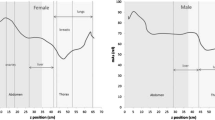Abstract
Among the various metrics to quantify CT radiation dose, organ dose is generally regarded as one of the best to reflect patient radiation burden. Organ dose is dependent on two main factors, namely patient anatomy and irradiation field. An accurate estimation of organ dose requires detailed modeling of both factors. The modeling of patient anatomy needs to reflect the anatomical diversity and complexity across the population so that the attributes of a given clinical patient can be properly accounted for. The modeling of the irradiation field needs to accurately reflect the CT system condition, especially the tube current modulation (TCM) technique. We present an atlas-based method to model patient anatomy via a library of computational phantoms with representative ages, sizes and genders. A clinical patient is matched with a corresponding computational phantom to obtain a representation of patient anatomy. The irradiation field of the CT system is modeled using a validated Monte Carlo simulation program. The tube current modulation profiles are simulated using a manufacturer-generalizable ray-tracing algorithm. Combining the patient model, Monte Carlo results, and TCM profile, organ doses are obtained by multiplying organ dose values from a fixed mA scan (normalized to CTDIvol-normalized, denoted as h organ ) and an adjustment factor that reflects the specific irradiation of each organ. The accuracy of the proposed method was quantified by simulating clinical abdominopelvic examinations of 58 patients. The predicted organ doses showed good agreement with simulated organ dose across all organs and modulation schemes. For an average CTDIvol of a CT exam of 10 mGy, the absolute median error across all organs was 0.64 mGy (−0.21 and 0.97 for 25th and 75th percentiles, respectively). The percentage differences were within 15%. The study demonstrates that it is feasible to estimate organ doses in clinical CT examinations for protocols without and with tube current modulation. The methodology can be used for both prospective and retrospective estimation of organ dose.




Similar content being viewed by others
References
McCollough CH, Guimaraes L, Fletcher JG (2009) In defense of body CT. AJR Am J Roentgenol 193:28–39
Brenner DJ, Hall EJ (2007) Computed tomography — an increasing source of radiation exposure. N Engl J Med 357:2277–2284
McCollough CH, Chen GH, Kalender W et al (2012) Achieving routine submillisievert CT scanning: report from the summit on management of radiation dose in CT. Radiology 264:567–580
Boone JM, Hendee WR, McNitt-Gray MF et al (2011) Radiation exposure from CT scans: how to close our knowledge gaps, monitor and safeguard exposure — proceedings and recommendations of the radiation dose summit, sponsored by NIBIB, February 24–25. Radiology 265:544–554
McCollough CH, Leng S, Yu L et al (2011) CT dose index and patient dose: they are not the same thing. Radiology 259:311–316
Gold JE, Park JS, Punnett L (2006) Work routinization and implications for ergonomic exposure assessment. Ergonomics 49:12–27
Turner AC, Zankl M, DeMarco JJ et al (2010) The feasibility of a scanner-independent technique to estimate organ dose from MDCT scans: using CTDIvol to account for differences between scanners. Med Phys 37:1816–1825
Tian X, Li X, Segars WP et al (2013) Dose coefficients in pediatric and adult abdominopelvic CT based on 100 patient models. Phys Med Biol 58:8755–8768
Li X, Samei E, Segars WP et al (2011) Patient-specific radiation dose and cancer risk estimation in CT: part II. Application to patients. Med Phys 38:408–419
Petoussi-Henss N, Zanki M, Fill U et al (2002) The GSF family of voxel phantoms. Phys Med Biol 47:89–106
Lee C, Lodwick D, Hurtado J et al (2010) The UF family of reference hybrid phantoms for computational radiation dosimetry. Phys Med Biol 55:339–363
Segars WP, Bond J, Frush J et al (2013) Population of anatomically variable 4D XCAT adult phantoms for imaging research and optimization. Med Phys 40:043701
Segars WP, Sturgeon G, Mendonca S et al (2010) 4D XCAT phantom for multimodality imaging research. Med Phys 37:4902–4915
Norris H, Zhang Y, Bond J et al (2014) A set of 4D pediatric XCAT reference phantoms for multimodality research. Med Phys 41:033701
International Commission on Radiological Protection (2007) The 2007 recommendations of the international commission on radiological protection, ICRP publication 103. Ann ICRP 37:2–4
Tian X, Li X, Segars WP et al (2014) Pediatric chest and abdominopelvic CT: organ dose estimation based on 42 patient models. Radiology 270:535–547
Li X, Samei E, Segars WP et al (2011) Patient-specific radiation dose and cancer risk for pediatric chest CT. Radiology 259:862–874
Dixon RL, Boone JM (2013) Dose equations for tube current modulation in CT scanning and the interpretation of the associated CTDIvol. Med Phys 40:111920
Li X, Segars WP, Samei E (2014) Generic assessment of organ dose for CT scans with different tube current modulation schemes. Phys Med Biol [In press]
Tian X, Li X, Segars WP et al (2014) Prospective optimization of CT under tube current modulation. I: Organ dose. SPIE Medical Imaging, International Society for Optics and Photonics, p 90331Q
Conflicts of interest
Dr. Samei receives grant support for research from GE Healthcare, Siemens Healthcare and Carestream Health. Drs. Tian and Segars have no financial interests, investigational or off-label uses to disclose.
Author information
Authors and Affiliations
Corresponding author
Rights and permissions
About this article
Cite this article
Samei, E., Tian, X. & Segars, W.P. Determining organ dose: the holy grail. Pediatr Radiol 44 (Suppl 3), 460–467 (2014). https://doi.org/10.1007/s00247-014-3117-7
Received:
Revised:
Accepted:
Published:
Issue Date:
DOI: https://doi.org/10.1007/s00247-014-3117-7




